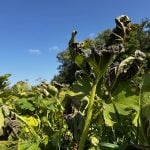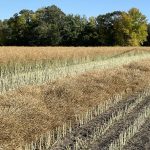SASKATOON – When David Anderson was looking for a way to diversify his grain farm he wanted something a little different.
Ostriches and elk were too expensive. Pigs, sheep and horses were too ordinary. He settled on Miniature Herefords.
Miniature Herefords look like their full-size relatives – just smaller.
“I think that they’re something that’s going to catch on,” said Anderson of Frontier, Sask.
There are only a handful of Miniature Hereford herds in Canada.
Miniature Herefords were developed by Rust Largent of Fort Davis, Tex. With the introduction of exotic cattle to North America during the 1970s came the trend to larger cattle. The west Texas cattle producer didn’t like the direction Herefords were heading. The cattle were getting larger without becoming more efficient.
Read Also

Trade war may create Canadian economic opportunities
Canada’s current tariff woes could open chances for long-term economic growth and a stronger Canadian economy, consultant says — It’s happened before.
“I don’t know why, the whole industry went crazy,” said Largent.
Closed herd
While the rest of the industry was breeding larger cattle, Largent closed his herd and designed his breeding program for smaller cattle.
It has taken 20 years to get a uniform group of Miniature Herefords. There are now about 500 Miniature Hereford, mostly in the United States.
Efficient size
While some regular-size Herefords can reach 165 centimetres tall, his animals are about half that size. His 91-cm minis are in demand for the exotic market and can sell for up to $27,000. The most efficient size for cattle producers are the 106 cm to 112 cm minis which sell for about $2,000.
Looking at a Miniature Hereford herd is like stepping back in time. The cattle are horned and look like old-style Herefords with heavier shoulders and a broad short head with a short neck.
Largent said he kept the old-style animals for their efficiency.
He said his 700 to 750 pound cows will wean a 500-lb. calf at seven months. That’s the same size calf an animal twice the size will wean.
“The beef industry destroyed the Herefords by not being competitive, efficiency-wise,” said Largent.
Pat Hay, who has eight Miniature Herefords on her Entwistle farm west of Edmonton, estimates she can feed three minis to one regular-size cow.
The hazard for Hay and Anderson is overfeeding the animals. One of Hay’s calves died because the cow was too fat.
Because the animals are smaller, it’s easy to treat them like pets rather than livestock.
“They’ve been a lot of fun. They’re really good natured,” said Anderson.
Anderson said in the summer the cattle were in a 20-acre pasture and got too fat. In the winter he feeds his three animals a small bale of hay every two days.
Because they’re cheaper to feed and easier to handle than standard size cattle, Anderson sees a market for the animals on acreages. The smaller animals don’t need the same handling facilities or amount of land to get a profitable herd.
Return of efficiency
Although Largent thinks the animals would be ideal for acreages, he believes in a few years the Miniature Hereford genetics will be in demand by other Hereford breeders to bring some efficiency back in the cattle herds.
“The old, traditional Hereford characteristics were good. Once they concentrated on size they lost a lot of the old characteristics.”
A common question Miniature Hereford owners are asked is whether the Miniatures are just a throwback to the dwarf Herefords that plagued the industry in the 1950s.
Lovell Kuykendall, assistant secretary of the American Hereford Association in Kansas City, Mo., said during the 1950s and 60s the Hereford association did extensive genetic testings to eliminate the dwarf gene. He said the association has done extensive pedigree checking and the animals associated with miniatures are free of dwarfism.
The Miniature Herefords have more than one registry. They can be registered with the Miniature Hereford Association and the American and Canadian Hereford Associations.
Kuykendall said the American association doesn’t have strict guidelines. As long as both the parents were registered, the offspring can be registered.
“Miniatures represent another aspect of the business,” said Kuykendall.
But Duncan Porteous, general manager of the Canadian Hereford Association in Calgary, isn’t as keen on the Miniature Herefords.
Porteous thinks the Miniature Herefords are just a fad or a “plaything.”
“It’s just like the horse industry. There’s working horses and miniatures.”














